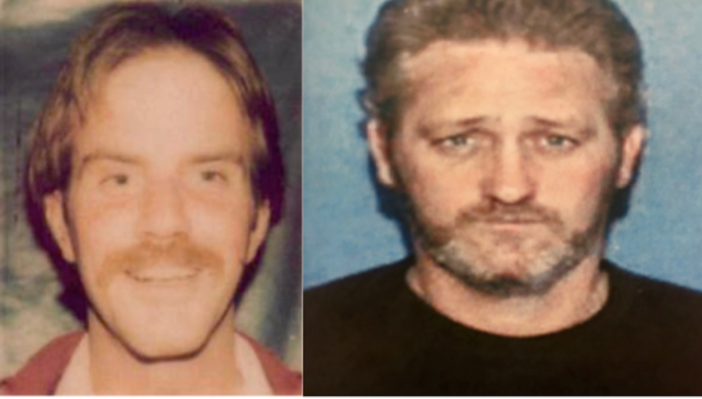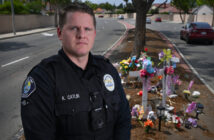His personal life in shambles following a break-up with his boyfriend, Brian Gene McNamara bellied up to the bar at Garden Grove’s Frat House, a popular watering hole for gay men.
It was Monday, March 19, 1990.
After several beers, McNamara, with sandy-blond hair and a reddish moustache that curled to his lower lip, flashed around a few hundred bucks his parents had given him to visit his brother in Garden Grove.
McNamara, 31, had left his parents’ home near Palm Springs and checked into what was then the Bestin Inn Motel at 8062 Garden Grove Blvd.
He last was seen leaving the Frat House around 7 p.m. that night accompanied by a man.
The two stopped by a liquor store and bought a 12-pack of Budweiser before heading to McNamara’s room.
Early the following afternoon, on March 20, 1990, two GGPD officers were on routine patrol in the parking lot of the Bestin Inn Motel when a frantic manager ran out and flagged them down.
The manager told the officers about the horrific scene a housekeeper had found inside McNamara’s room.
Clad only in underwear and white socks, a bloodied McNamara was found slumped between the bed and a wall.
There was blood all over the pillows, the white comforter, a wall.
McNamara’s wallet, emptied of cash, was on the bed.
A forensic pathologist at the Orange County Sheriff-Coroner later would determine that he had been stabbed 68 times.
Until a few months ago, Garden Grove PD detectives had, for some 27 years, been unable to determine who killed McNamara between the estimated hours of midnight and 1:30 a.m. on March 20, 1990.
Recently, they finally were able to find their killer.
But years ago, karma found him first.
***
GGPD detectives processed the bloody scene in the motel room and initially concluded McNamara was a victim of a robbery gone bad.
There were no signs of forced entry.
A murder weapon believed to be a knife never was found.
On the night he was viciously attacked, McNamara had made a call from the room at 9:28 to his ex-boyfriend, who didn’t pick up. That was McNamara’s last attempt at communicating with anyone.
Detectives had crime scene investigators run fingerprints found throughout the room, which included prints from maids and past guests. Eventually, detectives ruled out they belonged to any suspects.
Some partial prints found on a beer can weren’t good enough to link to a person.
As for the blood, investigators found several samples throughout the room that didn’t match McNamara’s.
“The killer apparently cut himself (or herself) while stabbing (McNamara), which actually is pretty common,” said GGPD Det. Michael Farley.
Some of the blood not belonging to McNamara was on the bed, on the inside and outside of McNamara’s wallet, and on the doorknob.
But no hits came up in the federal DNA database, then in its infancy. That meant the blood belonged to a person whose DNA wasn’t in the criminal justice system for a prior arrest.
Back in 1990, the FBI’s CODIS (Combined DNA Index System) only was a pilot software project serving 14 state and local laboratories. It was nowhere near the sophisticated system it is today that enables federal, state and local forensic laboratories to exchange and compare DNA profiles electronically to link violent crimes to each other and to known offenders.
After interviewing scores of people at the Frat House and Bestin Inn Motel, Garden Grove PD detectives were able to rule out possible suspects, including the man seen leaving the bar with McNamara the night he was butchered.
Time marched on, and eventually, the GGPD exhausted all leads.
The case went cold.
***
Last year, as a member of the GGPD’s cold case team, Farley decided to take another look at the McNamara case.
With technology light years from what it was in 1990, he asked Debbie Mele, who specializes in fingerprint examination as a lead forensic specialist for the Orange County Crime Lab and is on contract to the GGPD from the Orange County Sheriff-Coroner, to take another look at the partial prints found on the beer can in McNamara’s motel room.
That request turned out to be the break that eventually led to the identification of McNamara’s killer.
Mele, a 20-plus year fingerprint specialist, used improved fingerprint imaging software to look at the partial prints on the beer can. The software enabled her to look at more surface area of the prints and get more details.
Then, bingo.
Mele got a hit off the print.
It came back to a man from Rock Hill, S.C. named Danny Thomas Walker.
***
“Walker was not a nice guy,” Farley said in an understatement.
A drifter, Walker, who at the time of the McNamara slaying would have been 28, had been arrested multiple times in multiple states for robbery, assault with a deadly weapon and assault with intent to kill.
“I thought, ‘Holy cow, this guy fits the bill,’” Farley said.
Walker had a criminal history in Texas, California, North Carolina and South Carolina, Georgia and Florida, Farley said.
So the detective started digging.
He contacted the York County Sheriff’s Department in South Carolina to inquire about Walker.
Walker, they informed Farley, was dead.
In circumstances unclear to the veteran GGPD detective, Walker had been involved in a shooting sometime after the murder of McNamara in 1990.
The shooting left Walker paralyzed from the waist down and needing to use a wheelchair and a colostomy bag.
In 1999, Walker had a fatal heart attack while wheeling himself out of a bar in South Carolina.
He was 38.
Farley then contacted the York County Coroner in an effort to secure DNA evidence that would tie the blood found in McNamara’s room to Walker.
An autopsy had been performed on Walker, but his organs had been disposed of, Farley was told.
But the York County Coroner still had in its possession “pathology blocks” collected during Walker’s autopsy.
Farley had never heard of the term.
The coroner investigator told Farley that when an autopsy is conducted, organs are removed and sliced very thin, and then placed in paraffin wax and sandwiched between two slides to be examined under a microscope.
But since the slides had been sitting in storage for some 18 years, would DNA experts in Orange County be able to extract Walker’s DNA from the slides and then match that profile to the blood found in McNamara’s room?
The York County Sheriff’s Department got a court order to release the pathology blocks to Farley, and they were overnighted via FedEx to the GGPD.
Farley then sent the slides, contained in a box about one-quarter the size of a shoebox, to the OC Crime Lab, where forensic scientist Bobby Binz was assigned to examine them.
After a first go-around this Spring, things didn’t look too promising, Binz told Farley.
The challenge was isolating the human tissue from the wax and slides. It wasn’t a task normally performed at the OC Crime Lab, and it was something Binz had not done up to this point.
But Binz was up for the challenge, and excited to get a hit.
He amplified a sample on a pathology block — basically, he replicated it to get a better reading.
Then in April, on the day before he left for vacation, Binz called Farley with the news.
The DNA belonged to Walker, and it matched every single piece of blood evidence that had been unidentified in McNamara’s room.
Finally, the GGPD had their man — although he had been dead since 1999, the same year McNamara’s mother, Cynthia, passed away.
“It was Debbie who got the whole ball rolling on this case,” Farley said of Mele.
McNamara’s father, Ralph, also died before the killer of his son could be identified.
A Purple Heart recipient and Korean War and Vietnam War veteran, Ralph McNamara, a military sharp-shooter from Iowa, passed away on Feb. 4, 2011.
***
Farley and his GGPD colleagues believe Walker likely was in the bar the night McNamara flashed around cash, and that Walker saw McNamara as easy prey to rob.
Drunk and tall but thin at 160 pounds, McNamara would have been fairly easy to overcome in his motel room.
“It’s horrific,” Farley said of the killing.

Debbie Mele, a lead forensic specialist for the Orange County Crime Lab who is on contract to the GGPD from the Orange County Sheriff-Coroner, “got the whole ball rolling” on the cold case, Det. Michael Farley says. File photo by Steven Georges/Behind the Badge OC
Having solved the cold case, it was time for Farley and colleagues to inform relatives of McNamara that Brian’s killer had been identified. There was a brother in Arkansas and a sister in San Diego County.
Farley drove down to meet her at work, accompanied by Dave Dierking, the original lead detective on the McNamara case (who now is an investigator with the Orange County District Attorney’s Office), and Bob Romaine, a legendary O.C. investigator with many law enforcement agencies and currently working part-time on cold cases at the GGPD.
The three put McNamara’s brother on the speaker phone and went over their findings with him and McNamara’s sister.
“We were able to go back to the family and say we didn’t forget about you,” Farley said.
McNamara’s sister broke down in tears.
“It was kind of bittersweet for them,” Farley said.
Added the veteran detective: “I’m proud of these guys. I’ve been doing this a long time, and this is an energetic group of officers and others here at the GGPD who are committed to doing the right thing.”
 Behind the Badge
Behind the Badge




